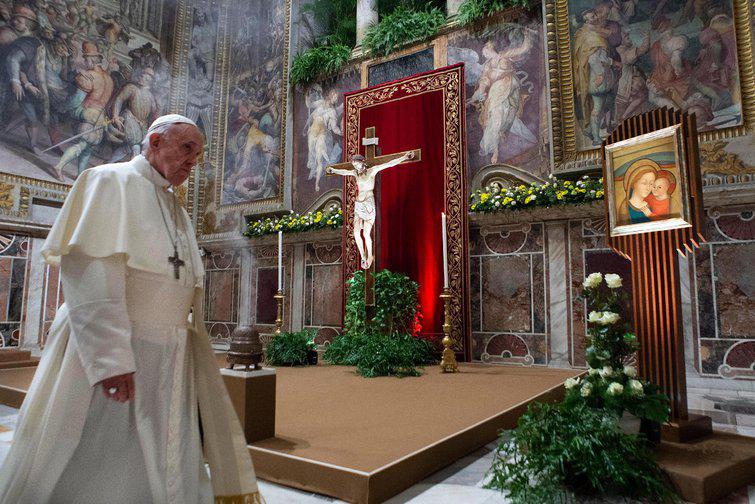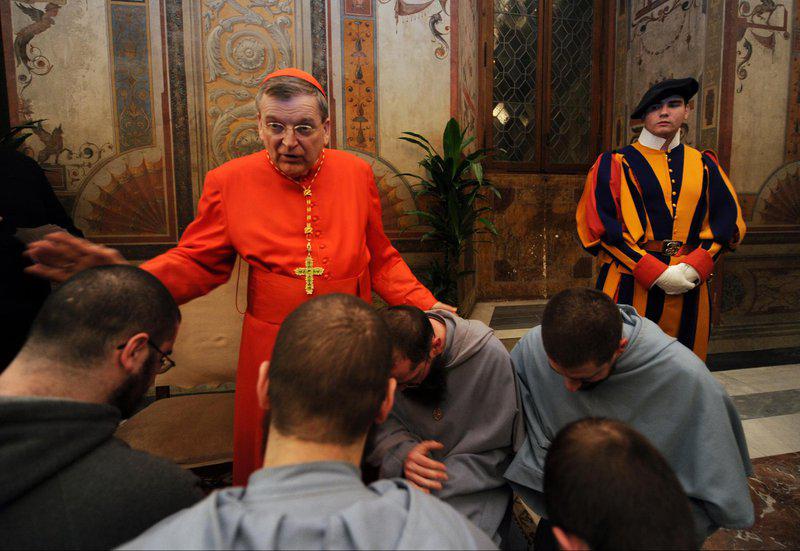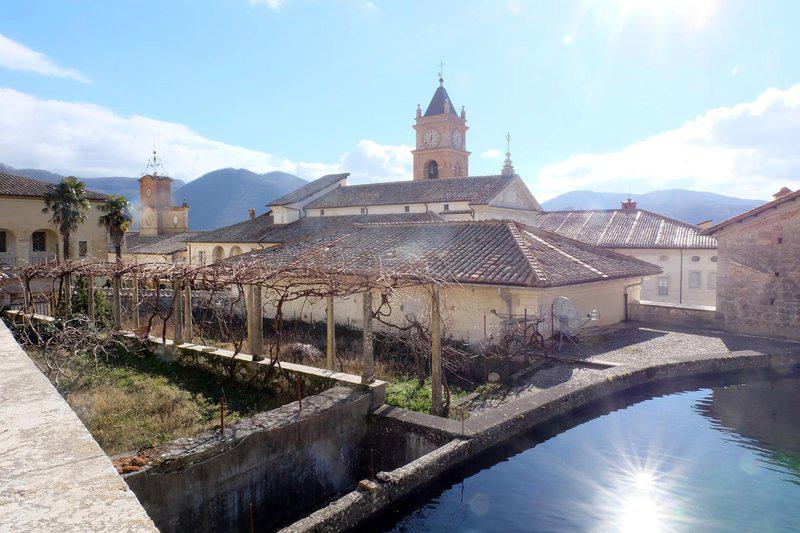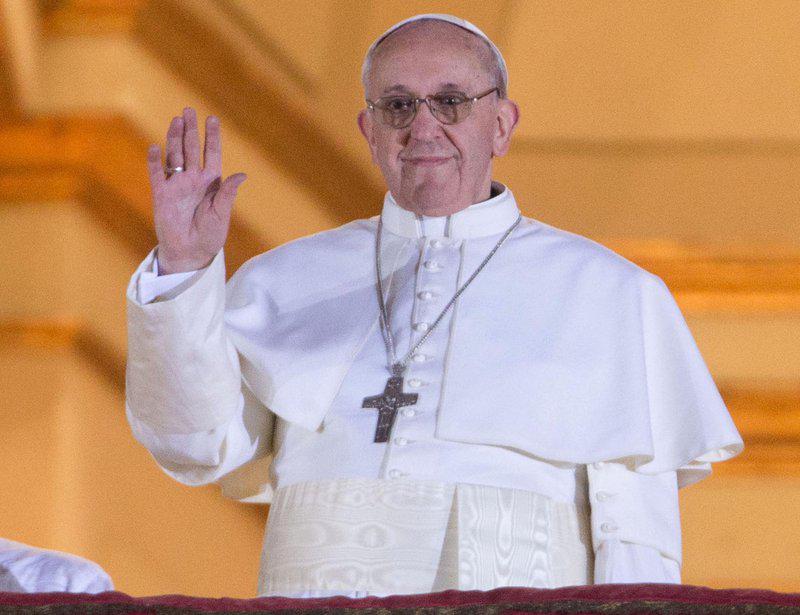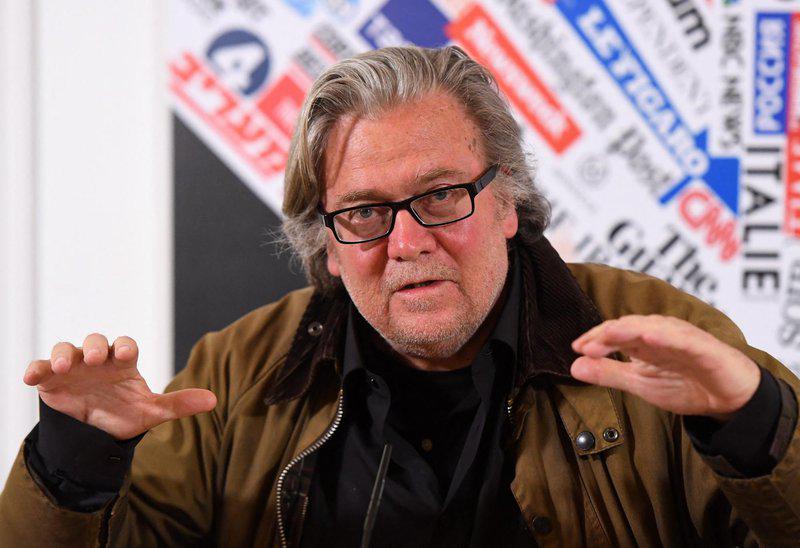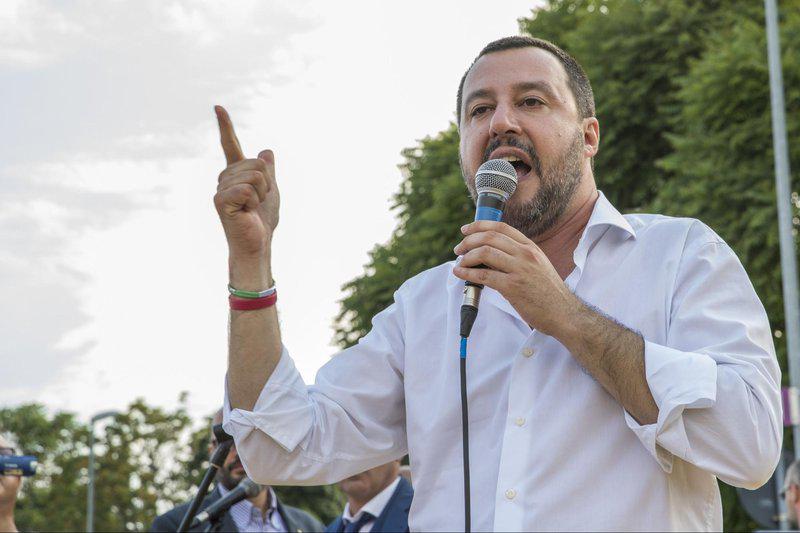|
How Pope Francis became a hate figure for the far right
By Leigh Baldwin, Marcus Lerous, Claudia Torrisi And Stefano Vergine
On a mountain outside Rome, Steve Bannon’s anti-immigrant populism joins forces with Catholic extremists who say a “gay plague” has infected the Vatican. In April 2016, at a campaign rally in Wilkes-Barre, Pennsylvania, a grinning Matteo Salvini – now deputy prime minister of Italy, and the leader of its far-right Lega party – photobombed another then-rising star of the populist right, Donald Trump. For the social media-savvy Salvini, it was a brilliant piece of publicity. It also caught the eye of Steve Bannon. Within 48 hours, the Italian politician was in Washington DC, meeting with the head of the attack-dog Breitbart news network who soon took over Trump’s campaign. Both Bannon and Salvini are now at the helm of grand plans to unite the right across Europe ahead of the European Parliament’s elections next month. Much of the conversation they had in 2016, before either had tasted triumph at the polls, remains a mystery. But a senior Lega party insider with knowledge of the events that day, who spoke to investigative journalists at SourceMaterial on condition of anonymity, said that Salvini emerged from his meeting with Bannon with a key piece of advice: attack the pope. Returning to Italy, Salvini did not take long to put this into action. “The pope says migrants are not a danger. Whatever!” he tweeted in May 2016. That summer, he was photographed holding up a t-shirt emblazoned with the words “Benedict is my pope”. That slogan is a Vatican version of the “birther” campaign that Trump waged against Barack Obama: that irregularities in the conclave that elected Francis, the current pope, make his papacy illegitimate – and that his predecessor, Benedict XVI, remains the ‘real’ pontiff. Meanwhile, Bannon – whose political vision centres on the defence of “Judeo-Christian values” in the West – has also become close to some of Francis’s most implacable foes in Rome, including the ultra-conservative Cardinal Raymond Burke. Burke, who has feuded with Francis since the outset of his papacy, is part of a group of hardline critics who claim that “organised networks” of LGBT people are spreading a “gay agenda” in the Vatican that they say is the root cause of recent sex abuse scandals. In 2017, Bannon became a patron of the Dignitatis Humanae Institute (DHI) ‘think tank’ – of which Burke is honorary president. Recently, his plans to use an ancient monastery outside of Rome as a ‘gladiator school’ for populists have prompted protests. They have also shone light on the network of individuals and groups on both sides of the Atlantic who have been driving anti-Francis campaigns – bringing together anti-immigrant populists, anti-abortion activists, alt-right celebrities and Catholic fundamentalists.
“Steve Bannon apparently doesn’t choose small targets”, said John Carr, a former policy chief at the US Conference of Catholic Bishops. “He helped make Trump President and now he wants to undermine the leadership for Pope Francis”. The DHI institute in Italy, of which Bannon is a patron, was founded by a British former Conservative party member called Benjamin Harnwell who converted to Catholicism in 2004 and was chief of staff for a British MEP, Nirj Deva, in Brussels until late 2010. Harnwell was introduced to Bannon by another American and former Brietbart contributor Austin Ruse, who runs a Catholic conservative lobby group called C-Fam that has been described as an anti-LGBT ‘hate group’ by the Southern Poverty Law Center. C-Fam has disputed this description, calling it a “false moniker has been wielded by those who oppose the natural family and marriage”. (With the natural family defined as a man, woman and their children and marriage as between opposite-sex couples only). Also on DHI’s board of trustees, “Austin is one of these people who has taken the pro-life cause and connected to a much larger agenda of conservative politics and power”, said Carr. The Institute’s chairman, meanwhile, is Luca Volonte, an Italian politician and anti-abortion campaigner who is currently on trial in Milan facing corruption charges. Leaked accounts from Voltonte’s charitable trust, seen by SourceMaterial, show the influx of more than a million euros from companies that were identified as part of a “laundromat” used to pump illicit cash into Europe from Azerbaijan and Russia. Bank statements for his Novae Terrae foundation from 2014 to 2017 show that among the first beneficiaries of this influx of funds was Harnwell, who received €12,000 in 2014. Others included Edward Pentin, a DHI communications consultant who received €1,000 that year. He told SourceMaterial this payment was for help arranging a DHI conference in 2014. Along with a business associate of Konstantin Malofeev, a Russian oligarch close to Vladimir Putin, both Ruse and Volonte are directors of the International Organization for the Family (IOF) that runs the World Congress of Families (WCF) network of ultra-conservatives. Others in DHI’s colourful cast include a “priest to the stars”; a chairman of the hard-right Bow Group think-tank whose flight to a WCF event in Moscow was paid by a Putin-linked oligarch; and a one-time lobbyist for Bosnian-Serb leader Radovan Karadzic.
Scandal at the ‘gladiator school’
“Let’s have an academy that brings the best thinkers together and it can actually train… what we call modern gladiators”, Bannon said in an interview with NBC’s Richard Engel in collaboration with SourceMaterial, of his controversial plans for a monastery outside Rome. This is the 13th century Trisulti monastery, perched on a hilltop an hour or so outside the Italian capital, that is at the center of a scandal over Bannon’s plan to use it to mould a new generation of Salvinis, Victor Orbans and Marienne Le Pens. “The people who come out of here they’ll be entering these organisations at either a junior level or mid-level and it’ll be five or 10 or 15 years until you start to see the impact”, he said, emphasising the long-term nature of his aim to train an army of populists. Bannon’s presence has already stirred up opposition from local residents, who have held demonstrations and questioned the legality of DHI’s acquisition of the monastery, pointing to inconsistencies in the tender process that could put its tenancy in peril. Tender rules require applicants to have legal status in Italy. But DHI did not register as a legal entity in Italy until five months after the tender had closed in January 2017. Contacted by SourceMaterial, Harnwell acknowledged the late registration but said it was within the rules. Meanwhile, documents submitted by Harnwell for the tender tell a different story: claiming that DHI acquired this legal status in December 2016. “Inconsistencies in the assignation of the Abbey to Dignitatis Humanae have emerged”, said Daniela Bianchi, who is organising the local demonstrations. “We are protesting because the Trisulti abbey is a public asset and it could have a totally different role”. The tender required that organisations bidding to use the monastery have the aim of protecting cultural sites written into their statutes. DHI only altered its statutes retroactively to meet this requirement, again months after the tender had closed. The lease was further conditional on the experience of running at least one culturally significant site in the preceding five years. DHI said it managed a one-room museum at a Benedictine convent close to the monastery – but it’s unclear if it ever opened. "It’s quite run-down – the building it is in was partly used as a warehouse for a neighboring farm”, said Riccardo Copiz, president of Sylvatica, a local cultural association. “They brought in items from Trisulti and from the Abbey of Casamari, making it appear that it was a museum, but no one has ever had the opportunity to access it”. A museum representative contacted by a SourceMaterial journalist, enquiring as a tourist, was not aware that a website listing opening times and ticket prices even existed. She said the museum is in the process of moving to a new site at the monastery itself. Most concerning, is how the Institute presented itself as a religious project despite Bannon’s more earthly plans, Bianchi says. “What they wrote in the proposal to the ministry does not coincide with what they said later – that they wanted to set up a ‘populist academy'.”
A different pope, a perfect target
From the start, Pope Francis was different. Eschewing his predecessors’ jewels and silks, he wore a simple cross of wood or metal and a plain white vestment, often of wool. Five months in, Francis delivered mass on the tiny Italian island of Lampedusa to commemorate thousands of migrants who drowned crossing the Mediterranean. Three weeks later, asked during a flight back from Brazil about his stance on homosexuality, Francis replied with his now famous dictum: “who am I to judge?”. And then came Laudato Si (Latin for “praise be to you”), his call for "swift and unified global action" on climate change. As the modernising pope gave hope to the Catholic Church’s reformers, conservatives (and populists like Salvini) began to rally around Benedict, still alive and living in Rome. To students of Trump’s politics, many of these anti-Francis voices sound eerily familiar. Michael Voris, who runs the hardline website Church Militant and is among the pope’s most vociferous critics, has for example claimed that “homosexual or homosexual-friendly” leaders are taking over the Vatican and that Francis needs to “drain the swamp”. Late last year, Milo Yiannopoulos, a former Bannon protege at Breitbart, published a book, Diabolical, with the Trump-esque rallying cry “make the Vatican straight again”. Analysis for SourceMaterial by the Institute of Strategic Dialogue, which works to counter right-wing extremism, meanwhile shows that several suspected Twitter “bots” that once pumped out pro-Trump messages have in the past year switched to attack Francis. “The idea that there is a gay mafia that’s taking over the church doesn’t make any sense”, said Jim Martin, a Jesuit priest and adviser to the Vatican in the US. “They’re using these people as whipping boys. It’s blaming the LGBT person… for all the ills in the church”. But, he added: “Some of the things that happened in the last presidential campaign showed people that hate sells and demonisation of people sells”.
Volonte was appointed chairman of DHI two days after Pope Benedict XVI announced his resignation from the papacy, in February 2013. This institute has become a key hub of anti-Francis critics – with Cardinal Burke chief among them. A few months after his election, the pope demoted Burke from a body that oversees the appointment of bishops. By the following year, the cardinal was publicly questioning the pontiff, saying: “There is a strong sense that the church is like a ship without a rudder". When Francis published his Amoris laetitia (“the joy of love”), which suggested that remarried divorcees could in some cases receive communion – anathema to ultra-conservatives – uneasy rumbling spilled into open conflict. In 2016, Burke and three other cardinals, including another DHI associate, Cardinal Walter Brandmueller, presented the pope with dubia (“doubts”), formally questioning his judgement in what amounted to a political earthquake in the Vatican. Last year, at a conference dedicated to his recently-deceased fellow dubia cardinal, Carlo Caffarra, Burke went as far as to suggest that Francis may be guilty of heresy. This February, Burke and Brandmueller wrote an open letter denouncing “the plague of the homosexual agenda [that] has been spread within the church”.
Attacking the pope
Attacking the pope is not done lightly. The pontiff is, by Catholic tradition, infallible, at least on matters of doctrine. “He’s the vicar of Christ on earth”, Bannon told SourceMaterial and NBC in an interview in Rome. “As far as the pope goes, I don’t really have an issue”. But he (as other critics do) appears to differentiate between Francis the spiritual leader and Francis the politician. In December 2018, he’d said the pope is “beneath contempt”. In our interview, Bannon said he has “many gay people in my family who are devout Catholics” – but “the gay mafia thing… something that’s got to be addressed”. Suggesting that, left unchecked, the abuse scandals could bankrupt the Church when compensation is paid, he added: “Pope Francis is not on top of this… We have an existential crisis in the Catholic Church today”. Through Francis’s views on immigration seem hardest for Bannon to forgive. As Trump campaigned in 2016 on a promise to build a wall on the US’s southern border, Francis said “a person who thinks only about building walls... and not of building bridges, is not Christian". A spokesman later denied it was a personal attack on Trump but Bannon remains aggrieved about what he views as interference, describing the homily that Pope Francis delivered, during mass on the Mexican border, as “kind of a throw-down on Trump”. The Lega party insider told SourceMaterial that it was specifically because of Francis’s stance on migration that Bannon urged Salvini to attack the pope at their 2016 meeting in Washington DC. Bannon himself did not respond to follow-up questions about this meeting.
The church has been hit by a series of scandals. In February, Theodore McCarrick, an American bishop, was defrocked amid allegations of serial abuse of minors. In March, George Pell, a cardinal, was also sentenced to six years in prison for sexual abuse. Sex abuse in the Catholic church has been in the public eye since the 2003 Boston Globe investigation – and the allegations against MacCarick and Pell date to long before Francis’s papacy. But even sympathetic observers say the pope has taken too long to act. His conservative opponents, meanwhile, have chosen the scandals as a key battleground. “People are weaponising the sexual abuse crisis for their own ideological economic ends”, said Carr, the former Conference of Catholic Bishops policy chief. Last year, Archbishop Carlo Maria Vigano, a former papal ambassador to the US, publicly accused Francis of hushing up McCarrick’s abuses in an open letter distributed through the media network of the American Catholic billionaire Timothy Busch. Busch owns the conservative Eternal World Television News television channel and the anti-Francis National Catholic Register newspaper, for which its Vatican correspondent, Edward Pentin – Dignitates Humanae’s communications adviser – ‘broke’ the story. There is also a Busch connection to a new US group called Better Church Governance that unveiled plans late last year to employ former FBI investigators to compile ‘The Red Hat Report’ on cardinals’ sexuality, doctrinal positions and any past misdemeanours. At the top of Better Church Governance’s list of targets are liberal clerics seen as close to Francis. In an interview with SourceMaterial, Tim Nielsen, the Red Hat Report’s editor, said the project is not an attack on Francis. “We really just want to give accurate information”. But others involved in setting up the initiative have hinted at influencing the next conclave. “What if we would have had someone else in 2013 who would have been more proactive in protecting the innocent and the young?” asked Jacob Imam, who has since left the project. Another of the group’s founders was Jay Richards, a professor at the Catholic American University’s Busch School of Business – set up by Timothy Busch with generous donations from the fundamentalist free-market philanthropist Charles Koch. “These are faithful Catholic laymen who love the church”, Richards tweeted in response to reporting on the Red Hat Report, which later removed his name from its website. “Their ‘agenda’ is to serve the church by improving transparency, not to lobby a conclave".
‘Free-market’ Catholics join the fight
Richards is executive editor of The Stream – a hardline anti-Francis publication for which the DHI trustee Austin Ruse is also a columnist. Like many of the pope’s American critics, he appears most preoccupied with the pontiff’s views on the free market – “an economy that kills,” according to a 2016 speech – and global warming, addressed in his climate change encyclical in 2015. “My worry is that Pope Francis has listened to advisers who have told him a lot of things about the science that are really just speculative predictions that aren’t even based on the best evidence”, said Richards in a video he posted online. At the time, he was a fellow at the Acton Institute, a ‘free-market’ Catholic think tank based in Grand Rapids, Michigan that also has offices in Rome. According to data analysis by openDemocracy, it has disclosed spending $1.7 million in Europe since 2008. Acton Institute donors include the family of Trump’s education secretary, Betsy DeVos, and her brother Erik Prince, founder of private military contractor Blackwater – and the Kochs. “The Acton Institute is a group of people who believe that Catholic social teaching as it’s traditionally understood is a threat to capitalism and so they want to redefine it, reorient it as a support for capitalism as we know it in this country”, says Carr. “Pope Francis represents an obstacle for their control of the dialogue and the economy and politics, and so… I think [in] a quite audacious way they decided they’re going to try and undermine, maybe even bring down a pope”. Acton founder Robert Sirico responded: “I would never identify myself as being against Pope Francis”. But, he said, “the pope doesn’t speak with the same moral authority on matters of economy or science or geography or the weather… as he does on faith and morals”. Unlike Bannon and Salvini, Acton has “a favourable disposition toward immigration”, according to Sirico – but tender documents for DHI’s monastery lease show the institute relied on Acton to support its application, detailing joint activities over a five-year period. Sirico said Acton participated in this process without his knowledge, through its Rome office, which he had since instructed to distance itself from DHI and Bannon.
‘Promoting the Gospel in the political sphere’
Letters posted on its website show how DHI lobbied repeated to obtain the monastery. In June 2015, shortly before the tender was announced, its honorary president at the time, Cardinal Martino, even wrote to the pope with a request to expedite the lease. “The Institute promotes the Gospel in the political sphere”, Martino wrote, though there was no mention of Bannon, populism or gladiators. (He stepped down from DHI in 2019, urging the institute in his resignation letter not to “distort” its aims, or “turn away” from the pope). It was around this time, in 2015, that Salvini began courting conservative religious voters with a new emphasis on “traditional” marriage. Previously, his Lega party had been avowedly secular and had even supported civil partnerships for same-sex couples. Umberto Bossi, who founded Lega Nord in 1991, as a campaign a campaign for an independent “Padania” in Italian territory north of Florence, identified the Fiat industrialist “Agnelli, the pope and the mafia” as the “vested interests” ranged against his voters. After his 2016 meeting with Bannon, Salvini stepped up his assault on the pope, realising that Francis made an ideal target for his anti-immigrant message – even as other top Lega officials urged him to moderate his tone, according to the party insider. In February 2017, shortly after the start of Bannon’s official association with DHI, Salvini held the first of several meetings with Burke. By early 2018, he was appearing in public clutching a rosary and calling for crucifixes to be displayed in public places. This March, it became clear just how cosy the Bannon-backed populist right has become with Francis-hating ‘Lavender Mafia’ conspiracy theorists – and fascists. Salvini was a headline speaker at the World Congress of Families (WCF) meeting in Verona. At the podium, Salvini said he has not been a perfect father or husband and has no interest “in bringing the state into the bedroom of anyone”. But he pledged to fight against surrogacy (which he said “disgusts” him) and “the theory of gender… until it changes”. Right before this meeting, Bannon was in Rome. Shortly after, Salvini invited representatives of numerous far-right parties to a meeting in Milan, where he launched a new initiative to unite nationalist and traditionalist populist parties ahead of the European elections.
Russians, Catholics and fascists unite
The WCF network draws together religious conservatives from around the world to discuss and share strategies against same-sex marriage, abortion and “gender ideology”. One of its leading figures is the Russian campaigner Alexey Komov, who also spoke at a launch event to open the DHI office in Rome, in 2013. The son of a diplomat expelled from Britain as a KGB spy in 1985, Komov is a protege of the “Orthodox Oligarch” Konstantin Malofeev who has been targeted by US and European sanctions for allegedly propping up the pro-Russian breakaway republic in eastern Ukraine. Both Volonte and Komov are also directors of CitizenGo, an ultraconservative answer to Avaaz or Moveon.org that campaigned in the UK on the case of Charlie Gard, a terminally ill British baby whose life support was withdrawn after a court ruling. Outside the Verona meeting, a local official for the Forza Nuova neo-fascist party held a press conference and announced a campain for a national referendum on Italy’s abortion law. Inside, a German princess joined a leading American anti-LGBT rights activist on stage. Princess Gloria von Thurn und Taxis – a friend of Pope Benedict, patron of populist Christian causes and potential financial backer of Bannon’s plans in Europe, took a seat next to Brian Brown, who made one of the event’s numerous references to Francis’s predecessor. In Rome, Roberto de Mattei, a leading figure in Italy’s conservative Catholic circles, said Francis’s “pontificate is finished. Not from a chronological point of view – I don’t know if it will be tomorrow or one year – but from a logical point of view… This year could be decisive". “What they’re after is undermining his credibility, his authority, his capacity to lead, and they’re having some impact”, said Carr, the former US Conference of Catholic Bishops policy chief, of the pope’s critics. He acknowledged that the pope has made errors and has been too slow in responding to the sex abuse crisis. But the chances of Francis becoming the second pope in succession to resign are overstated, he said. “Pope Francis is not going to resign. He can’t be removed”.
|
.
Any original material on these pages is copyright © BishopAccountability.org 2004. Reproduce freely with attribution.
